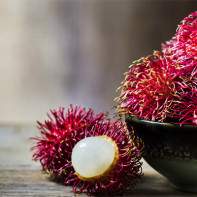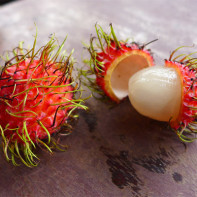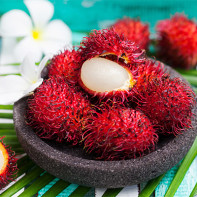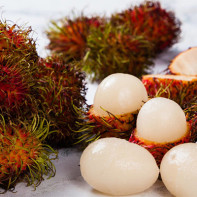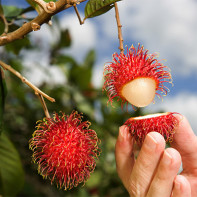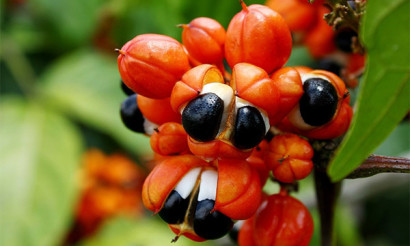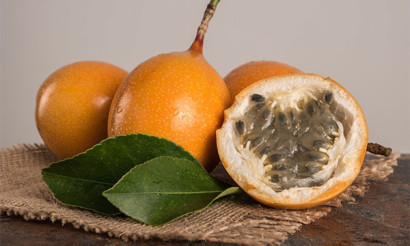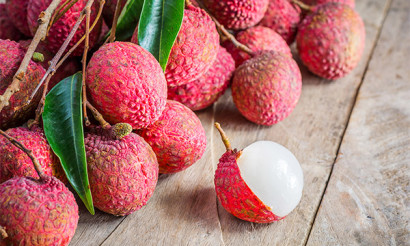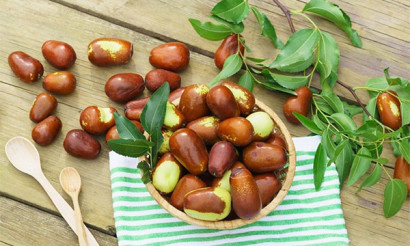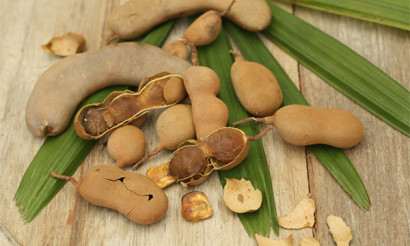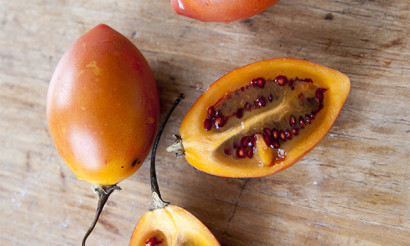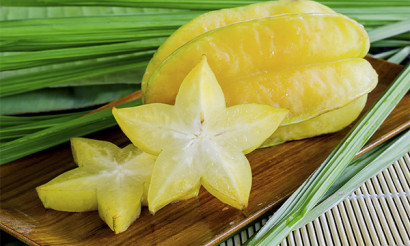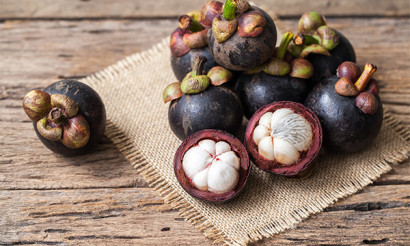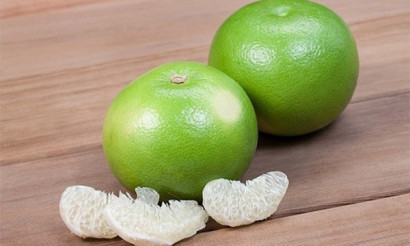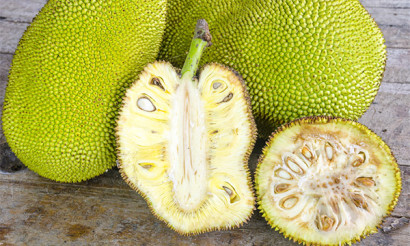Rambutan fruit: useful properties and contraindications
Rambutan is a tropical plant with unusual fruits, which in appearance slightly resemble chestnuts, but differ in size. The fruit of this tree is a rarity and an exotic delicacy outside the regions where the plant is cultivated. The reason for this is the impossibility of storing the fruit for a long time. But this fruit is incredibly healthy and is even used in alternative medicine to treat many diseases.
- What is rambutan
- What it looks like and where it grows
- Use
- Composition and calories
- Useful properties of rambutan fruit
- General benefits
- For Women
- For Men
- In Pregnancy
- Breastfeeding
- For children
- Slimming
- Medical Uses of Rambutan Fruit
- Cosmetic Applications
- Rambutan in Cooking
- Fruit platter
- Seafood Salad
- Ice Cream
- Jam
- Hazards and contraindications
- How to choose and store
- How to eat rambutan
- How to peel it.
- Is it possible to eat rambutan?
- Interesting Facts
What is rambutan
Rambutan is a popular fruit in Southeast Asia that grows on evergreen trees with sprawling, large crowns. The fruit of the plant was not eaten for a long time, but once the inhabitants of the tropics discovered its unmatched taste, it became one of the popular delicacies on Asian tables.
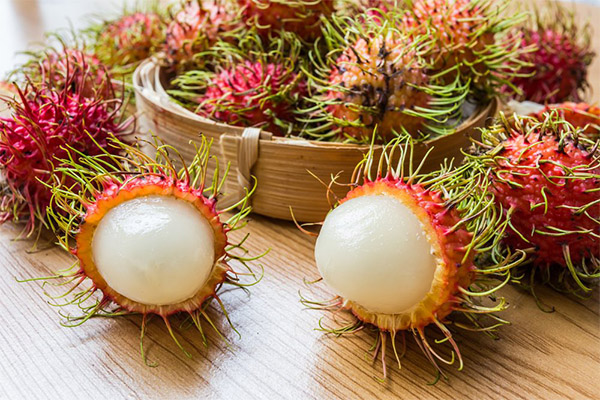
What it looks like and where it grows
Rambutan is a plant that is a member of the family Sapindaceae and belongs to the genus Nephelium. The plant is an evergreen tree that ranges in height from 12 to 25 meters. As a rule, they are tall trees with voluminous crowns. Leaves are large, paired, rich green in color with pronounced veins. Rambutan is distinguished by beautiful flowering - the whole tree is covered with small flowers, collected in large inflorescences.
When the flowering stage is over, the trees form large bunches of fruit. Each bunch can hold up to 25-30 round-shaped fruits. The fruits have an unusual appearance; they are covered with a skin with small, fibrous sprouts on it. This makes them look a bit like chestnuts. But the difference is that the fruits of rambutan are covered with soft, fibrous sprouts that resemble hairs, rather than thorns.
The greatest value in this plant is the fruit. They are suitable for food and have high taste qualities. Rambutan fruits 3 to 6 cm in diameter, under the thick skin hide juicy, gelatinous flesh, in the center of which there is a small almond-shaped pit. At first the rambutan skin is light green in color, but as it ripens it takes on a reddish or maroon color.
Use
In Indonesia, Thailand, and other Asian countries, rambutan is used as a food. The sweet fruit is served fresh in many food establishments, and in some tourist regions it is one of the most popular foods. Therefore, most often the fruit of the plant is used in cooking. But apart from that, the fruits and other parts of the plant are used in other areas.
Today, rambutan is well studied by science, which has made it in demand in the cosmetics industry. The fruits, seeds, oil, and extracts from the leaves and roots are actively used to create cosmetic care products. Rambutan oil is used in elite lines of body care products as well as for hair removal.
Rambutan is also used by some dietary supplement manufacturers as a herbal medicinal component. Traditional medicine does not use rambutan due to a lack of research on its effects. There is also no data on the subject of potential harms and benefits of treatments based on the extract and herbal extract.
Composition and calories
The rambutan fruit consists of 77% water, which makes the flesh quite juicy. 100 grams of the product contains from 80 to 88 kcal, depending on the degree of ripeness. The riper the product, the more carbohydrates - sugar - it contains. But the pulp contains many active components, the presence of which is due to the useful properties of the fruit.
- Vitamins in the pulp: C, A, PP, B1, B2, B6, E, K.
- Macro-and micronutrients: potassium, phosphorus, sodium, iron, calcium, zinc, magnesium.
- Nicotinic acid.
- Antioxidants.
- Fatty, organic and fruit acids.
Due to such a rich composition, rambutan fruits bring health benefits and significantly help with various diseases. Therefore, the plant can be used as an effective preventive and therapeutic agent.
Useful properties of rambutan fruit

General benefits
Rambutan is considered one of the important products for health and longevity. It has a wide range of useful properties, due to which it is highly valued in traditional and non-traditional medicine. Currently known medicinal properties of the plant, which are actively used in folk medicine:
- anti-inflammatory;
- antibacterial;
- anti-tumor;
- laxative;
- antioxidant.
Regular consumption of rambutan in food leads to a significant slowing of aging processes. Due to the high content of organic acids the fruits of this plant contribute to the rapid removal of cholesterol from the body. Active ingredients thin the blood, strengthen the walls of blood vessels, thereby improving blood flow to tissues and organs. Due to the presence of antioxidants and a number of mineral compounds rambutan beneficial effect on the brain and nervous system in general. These substances lead to improved memory, protect neurons from damage, accelerate recovery from severe stress and mental stress.
Useful properties of rambutan can be used in the treatment of various diseases, and due to the content of active ingredients in high concentrations have different effects on the male and female body.
For women
Rambutan is useful for women's health and beauty. Women in Thailand have been using the power of this fruit for centuries to prolong youth, provide nourishment to the hair and skin. It also helps prevent the development of hormone-dependent tumors. Using this product in the diet significantly reduces the risk of breast cancer, cysts and benign growths in the organs of the reproductive system.
Due to the high content of minerals and fatty acids, the pulp of this fruit has a beneficial effect on the hormonal background. If you eat at least once a week for 100-200 grams of fruit pulp, you can avoid unstable hormonal background, prevent menstrual cycle disorders, and generally improve the well-being and increase the body's resistance to various kinds of irritants and aggressive environment.
For men
No less useful is the use of rambutan fruits for men. On the health of the stronger sex they have no less significant effect. Here is how the use of rambutan for men:
- Eliminates the risk of inflammation in the organs of the urinary and genital systems.
- Reduces the level of stress.
- Slows the aging process of internal organs.
- The blood is purified.
- Tissues and cells of organs are protected against the development of malignant and benign tumors.
Regular consumption of rambutan can increase libido, inhibit the development of erectile dysfunction and protect the prostate gland from inflammation. The main thing is to properly dose this product in the diet, as an excessive amount can lead to undesirable consequences for the body.
When pregnant
There are no strict restrictions on the use of rambutan during pregnancy. However, before introducing this product into the diet, it is worth consulting a doctor. Especially critical is the use in the diet of unfamiliar exotic products in the third trimester of pregnancy, because the reaction of the body is unknown. But still, this fruit is not only allowed to pregnant women, it is also very useful. Here are the main benefits of eating rambutan fruit:
- Complete replenishment of vitamin and mineral deficiencies;
- protection of bones from thinning and loss of calcium;
- stabilization of blood composition;
- prevention of anemia;
- strengthening of the immune system;
- normalization of the hormonal background;
- support of the nervous system;
- protection of the skin from the appearance of stretch marks, skin rashes and acne.
The only important warning is not to abuse this fruit, especially if it was rarely consumed before pregnancy. The problem is that rambutan raises blood sugar levels and can also provoke an increase in blood pressure. These two side effects are highly undesirable during pregnancy.
During Breastfeeding
During breastfeeding, pediatricians do not recommend the use of rambutan, as it can negatively affect the health and well-being of the baby. The fact that the child's body up to 1-1.5 years is in an active development and formation stage. Any extra strain on the digestive system can provoke indigestion, pain and cramps, increased gas formation.
Doctors also do not recommend introducing exotic fruits into the diet of a nursing mother because of the high risk of allergic reactions. For infants, even a small amount of an allergen can cause severe conditions up to and including anaphylactic shock and Quincke's edema. Therefore, it is not worth the risk.
But in the old days, and even today in the regions where rambutan grows, its fruits were used for women during the breastfeeding period, and were considered one of the most important components of the diet. Rambutan stimulates lactation and promotes rapid postpartum recovery. Due to the high concentration of minerals, it strengthens the nervous system, helps recover from overwork and increases resistance to stress.
For kids
Pediatricians in the CIS countries do not give unambiguous recommendations regarding the use of such an exotic product as rambutan in children's diets. This is not surprising, because in these latitudes such a product is a rarity. Nevertheless it is not difficult to buy rambutan, therefore you should still consult your doctor before giving your child a taste of this exotic fruit. Contraindications for children are the same as for adults - individual intolerance, as well as severe gastrointestinal diseases in the acute stage.
A very important nuance - it is strictly forbidden to introduce rambutan in the diet of a child under three years of age. At this stage, the baby's digestive system is not yet fully formed, so the use of an unusual product can provoke severe diarrhea and even general intoxication of the body. In rare cases, there may be an allergic reaction, and quite strong, because the fruit contains a large number of active natural ingredients in high concentrations.
When losing weight
It is not possible to lose weight with rambutan, because it is quite caloric. But you can use it as one of the acceptable products in the diet. The fruit is a great substitute for sweets, but this is not the only thing that makes rambutan a valuable component of the diet of a slimming person. Here are the main benefits of this fruit:
- activates metabolic processes;
- promotes fat burning;
- restores water-salt balance;
- reduces the feeling of hunger;
- Improves skin condition.
In strict diets it is necessary to include rambutan in your diet, because it compensates the deficiency of minerals and vitamins. It is desirable to eat this product in the first half of the day, because it is rich in carbohydrates.
Medical uses of rambutan fruit
In traditional medicine rambutan is practically not used, but Asian folk healers have been using it since ancient times and still consider this plant as a panacea for all diseases. In alternative medicine, not only the fruit, but also other parts of the plant are used. The most popular recipes for medicines based on this plant are described below.
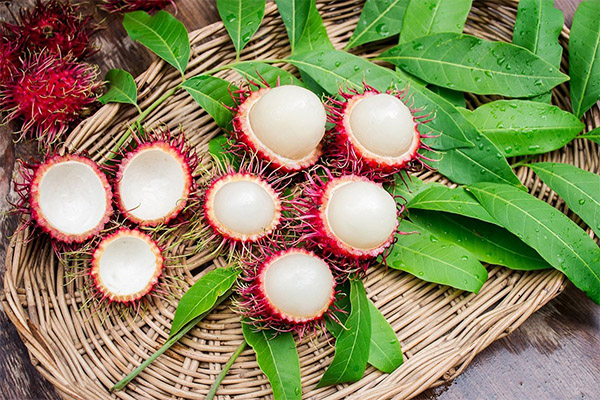
- To strengthen the immune system, it is recommended to use fresh juice from the pulp of the fruit by 150 ml every morning, 10-15 minutes before a meal.
- For the prevention and treatment of cancer, it is also better to use the fruit. They must be consumed daily 200-250 g for 2 weeks during the season. Longer rambutan should not be eaten, because there is a risk of digestive disorders.
- An infusion of rambutan leaves is used as a general tonic. You need to crush dry leaves, boil 200 ml of boiling water with 1 teaspoon of raw materials. Insist under a lid for 5-7 minutes and drink during the day in three drinks. Repeat for 5-7 days.
- Rambutan leaves can be used to prepare a decoction. You need 1 tablespoon of raw material to boil in 400 ml of water in a steam bath, and then insist until it cools. Strain the drink and store in the refrigerator, take 50 ml 3-4 times a day before meals for a week.
- Rambutan purée can be used as a laxative for constipation. To do this you need to prepare a portion of mashed potatoes just before admission.
- In diseases of the throat is recommended to use the fruit pulp with honey, in a ratio of 1:1. If along with a sore throat there is a cough, you should add a pinch of ground dried ginger or 1 teaspoon of fresh, ground on a grater to the medicinal remedy. Take such a remedy should be 4-5 times a day, 1 teaspoon.
- For diseases of the genitourinary system, it is recommended to take the fruit pulp in the processed form, that is, boiled or baked. The fact is that the acids that the fruit contains, can only increase inflammation. To improve the body's resistance to acute inflammatory processes in the genitourinary organs, you can eat 100-150 grams of pureed fruit every day.
Cold infusion of rambutan leaves can be used as a means to restore strength, a powerful tonic. You can take to improve lactation tea with the addition of rambutan.
Its cosmetic applications
Also the pulp of the fruit can be used in skin and hair care. The simplest masks are described below.
- The pulp of one fruit, 1 teaspoon of olive oil, a pinch of cinnamon - all mixed and applied to problematic and inflammation-prone skin. Wash off after 10 minutes.
- Mix 1 teaspoon of fruit pulp with the same amount of lemon juice and apply to pigmented skin for whitening. Use only in autumn and winter, apply SPF-50 cream after application.
Rambutan in cooking
Most often rambutan is used in cooking in raw and fresh forms. The fruit has a rich, sour-sweet taste and subtle aroma, so it can be served as a separate dish, such as on skewers, in fruit slices or simply in a basket with berries and fruits. But rambutan can also be used in exotic desserts, side dishes, and salads.

Fruit slicing.
The easiest and most effective way to serve rambutan is with fruit cut skewers. Rambutan goes well with the following fruits and berries:
- strawberries;
- grapes;
- blackberries;
- plum;
- pear;
- mango;
- banana;
- feijoa;
- pitahaya.
In order to prepare a spectacular fruit platter and serve it, you must first wash and peel all the prepared fruit. Especially carefully prepare the pulp of rambutan. To take out the pit, you need to use wooden sticks. The rest of the fruit can be cut into cubes or slices of other shapes, as desired.
Salad with seafood
Rambutan goes well with seafood, so you can use it in salads and side dishes as an accompaniment. Here is one version of a recipe for squid and rambutan salad. Ingredients:
- 3 squid carcasses;
- 150 g of hard cheese (any kind, preferably with a bitterness);
- 1 red onion;
- 3-4 rambutan fruits;
- lime juice;
- olive oil;
- handful of pine nuts;
- salt and pepper to taste.
The squid should be peeled and boiled in salted water on low heat for no longer than 10 minutes. Immediately, while the carcass is still cold, cut, sprinkle with oil and vinegar, salt and pepper, put the rings in a salad bowl. When the squid cools, add the diced or shredded cheese and onion chopped in half rings. Add the rambutan flesh at the very end, cut in halves or quarters. Make a dressing of lime juice and olive oil, salt and pepper, and sprinkle the salad with pine nuts before serving.
Ice Cream
Since rambutan is quite sweet, you can make ice cream from it even without adding sugar. But, if it's a classic creamy recipe, you need to use powdered sugar. Here is one of the best recipe options.
Ingredients:
- 300 g of fruit pulp;
- 300 ml of cream;
- 5 tablespoons of powdered sugar;
- A little vanilla.
Grind with a blender the pulp of the fruit, but be sure to remove the seeds. Separately, whip the cream and powdered sugar into a foam. When the cream is whipped, cool it a little, and then start whipping again at medium speed, gradually pouring in the mushy fruit pulp. At the very end, add the vanilla and place in the freezer for 3 hours. Before serving, you can use a special spoon to form beautiful balls, pour them with berry syrup, caramel or chocolate topping.
Jam
You can prepare the most delicate jam from the pulp of fruits, which will have a jelly-like consistency. With such a jam you can make pancakes, use it for sandwiches or any other dishes. To prepare it is very simple. It is necessary to take the following ingredients:
- 1 kg of fruit;
- 600 grams of sugar;
- 1 bag of thickener.
Peel and chop the fruits, then put them in a deep saucepan and cover with sugar. Cover with a lid and leave for 30 minutes. After half an hour, start boiling at minimum temperatures. It is important to stir the jam constantly, so that it does not stick. After 40 minutes, cool and pack in jars.
Harms and contraindications
Rambutan contains a lot of different types of sugar, so it should be used with caution in diabetes. It is also not recommended to use in large quantities with frequent attacks of hypertension. These diseases are not categorical contraindications - everything is determined individually. It is necessary to consult a doctor and find out how much fruit will be safe and useful for the body.
But there are such contraindications, in which it is necessary to completely exclude the use of fruits of this plant.
- Allergic reaction - hypersensitivity. If symptoms of allergy (itching, redness, swelling) appeared after consumption, it is necessary to refuse and take antihistamine medication, then immediately go to the doctor.
- Acute diseases of the digestive system - colitis, gastritis, pancreatitis, cholecystitis.
It is important to remember that rambutan has a pronounced laxative effect. Natives of the countries where the fruit grows are already adapted to this feature, and their bodies have almost no reaction to rambutan. People who do not eat it as part of their daily lives should consume it in moderation to avoid diarrhea.
Another important warning - under no circumstances eat the product together with the pit, it is fraught with severe intoxication of the body. If the bones have been eaten raw, you need to perform a gastric lavage and take a sorbent. Nevertheless, it is possible to eat boiled bones, because due to the heat treatment the toxins lose their concentration and cease to pose a danger to human health.
Also you should not forget about the norm - the maximum single serving is 250 grams. If you eat more than the pulp of the fruit, the following symptoms may appear:
- nausea;
- indigestion;
- flatulence;
- abdominal cramps;
- vomiting;
- diarrhea;
- Intoxication (in rare cases).
If you use rambutan in moderation, you can get a lot of benefits from it. Excessive consumption of the product is fraught with dangerous consequences, so do not exceed the recommended rate.
How to choose and store
It is necessary to choose only fresh fruits, because rambutan has a rather limited shelf life. There are some rules and tips that will help you choose the freshest fruit and keep it as fresh as possible.
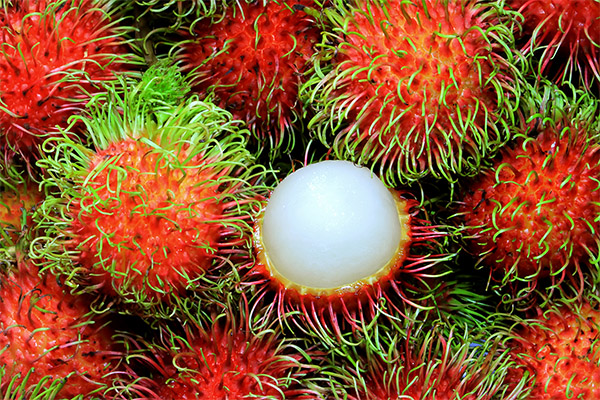
- It is important to pay attention to the smell of the fruit - there should not be rotten notes, only such fruits can be eaten. The presence of a putrid or sour smell is a sign that fermentation has begun in the pulp. The use of such fruit can lead to digestive disorders.
- It is important to pay attention to the integrity of the peel. Products with intact rinds will keep longer.
- The color of the fibers is a reference point by which you can determine the level of ripeness of the fruit. They must be a reddish color. If the rambutan is covered with green skin with sparse red spots, it is an indication that it is not yet ripe. Such fruits will not be very tasty.
- A good-quality, moderately ripe rambutan is not too soft. Excessively soft fruits are sweet enough, but they should not be stored.
- In order for rambutan to keep in the refrigerator for 5-7 days, you should choose unpeeled fruits. Often supermarkets sell only the pulp in portion trays - you can eat it, but you will have to do it at once.
In countries where rambutan grows, it is best to buy it on the outskirts or in villages where there are plantations of these trees. There it will be fresher, juicier and cheaper.
How to eat rambutan correctly
Rambutan can be eaten in any form - it is good both raw and after heat treatment. You do not need to know any special rules to enjoy this exotic fruit. All you need to do is properly peel and remove the bone from the pulp.
How to peel
To peel the fruit, you do not need to take a knife or any other devices. The skin is easy enough to remove by hand. In the central part of the fruit there is a natural natural seam, by pressing it, you can remove the upper half of the skin. After that, the second half should be removed in the same way. The process is similar to peeling a chestnut, the only difference is that you should not put too much pressure on the rambutan, as this can damage the flesh.
The inside can be cut in two halves with a very sharp knife, and in the process take out the pit. The pulp can then be served as a separate dish or used to make various desserts, juices, snacks and drinks.
Is it safe to eat the pit?
Rambutan pips contain toxic substances which evaporate rather quickly after being cooked. In Asian countries, seeds are considered a delicacy and useful product that produces the following effects:
- strengthens nails and hair;
- relieves constipation;
- protects and cleanses the liver;
- stimulates brain activity;
- it improves the condition of the skin;
- protects blood vessels from thrombosis, varicose veins.
The bone can be eaten, but for it to be absolutely safe for health, it should be roasted or thoroughly dried in the oven. It is pleasant enough to taste, can serve as an additive to desserts made from the pulp of the fruit.
Interesting Facts
Rambutan is a rather unusual fruit, which for a long time remained without the attention of gourmets, because it does not have a very appetizing appearance. There are many interesting facts associated with its use and cultivation.
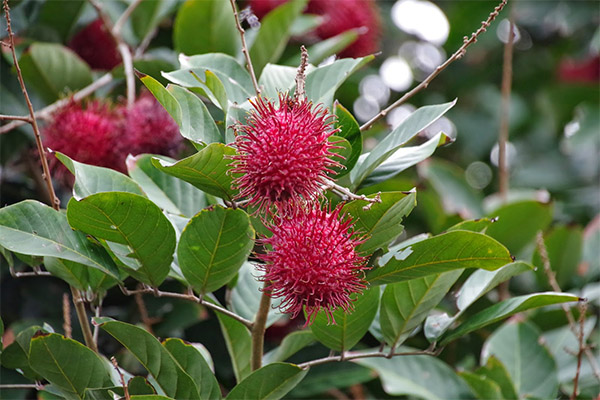
- Rambutan began to be used massively in cooking only three centuries ago, before that even in its homeland it was not too appreciated.
- Scientists were able to prove in studies the ability of this plant to slow the aging process and prolong life.
- Some high-end Israeli cosmetics brands use extracts from the plant.
- Rambutan used to be the basis for spirits in the past.
Rambutan is an exotic fruit with an unassuming appearance but a rich taste and a high concentration of biologically active substances. If you use this product in the diet correctly, not forgetting about the recommended rate, it will affect the body only beneficially.
«Important: All information on the site is provided solely for introductory for your own health. Consult with a health care professional before using any recommendations. specialist. Neither the editors nor the authors are liable for any possible harm caused by materials."

